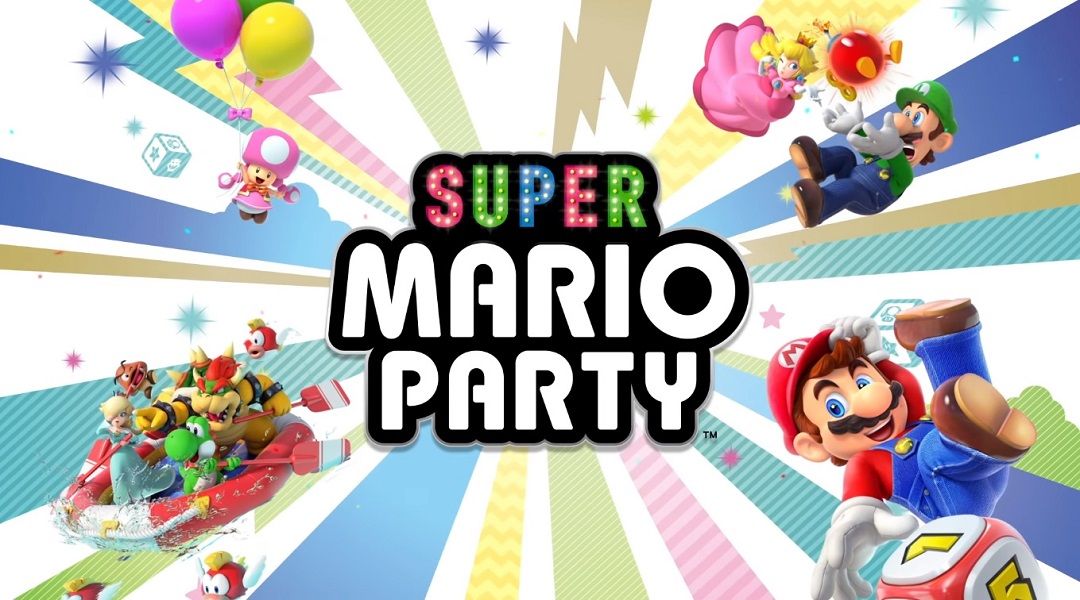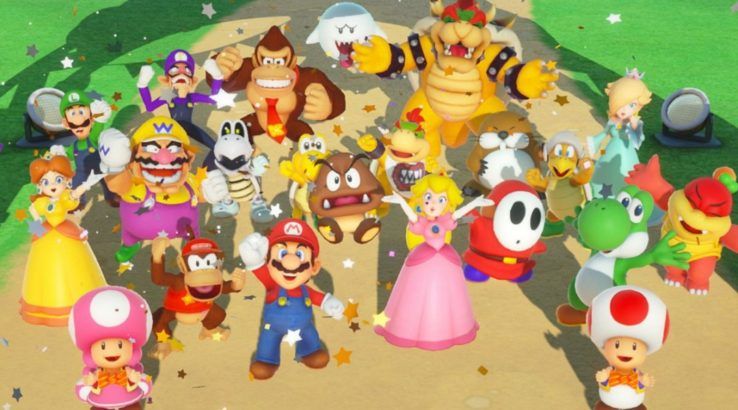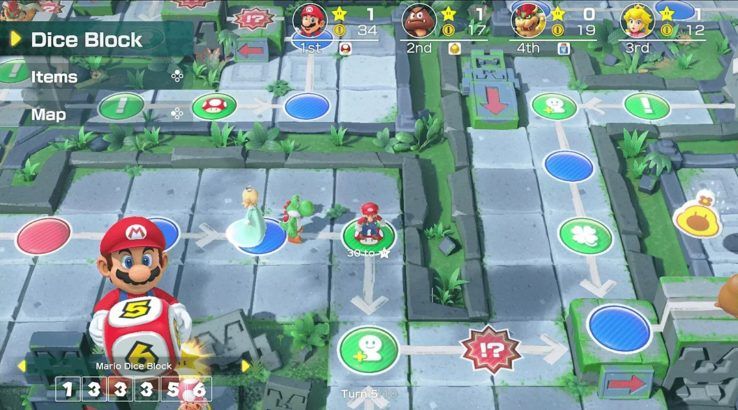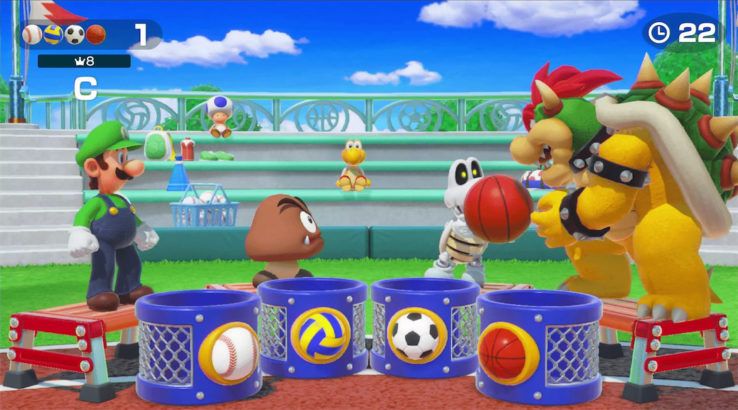Every single Nintendo console since the franchise debuted on the Nintendo 64 in 1998 has seen a Mario Party game. Considering this, it was only a matter of time until Super Mario Party was announced for the Nintendo Switch. Despite being the 11th main series Mario Party game, Super Mario Party has enough new ideas to actually feel different from its predecessors, but that doesn't necessarily mean it's a better game.
Anyone that has played a Mario Party game should know exactly what to expect from Super Mario Party. In the standard game mode, various Super Mario franchise characters like Mario, Luigi, Peach, Bowser, and more move around a gimmicky game board, attempting to collect coins as well as Power Stars. Along the way, they can also gather items to give them an advantage or manipulate the board by landing on special event spaces. Between rounds, players face off in one of 80 different mini-games, which is where the real fun lies, as moving around the game board can be tedious.
In past Mario Party games, the board game segments have been notoriously slow, and while things are sped up a bit in Super Mario Party, it can still drag at times. There are no real surprises on any of the boards after playing through them once, and players are always subjected to annoying cut-scenes that only serve to disrupt the flow of the game even more. What's worse is that these cut-scenes are the same on every board, with Kamek cursing the Bad Luck spaces to dish out even worse outcomes and the person in last place being rewarded with coins or items to help them get back in the running. These intrusive cut-scenes only serve to make the board game segments of the game even slower and they only get more annoying with time.
Keeping players engaged for the long term is an area that Super Mario Party struggles with in general. The mini-games become repetitive before too long, and while they're fun at first, they get old quick. 80 mini-games seems like a lot, but it's really not enough to sustain this game for long-term enjoyment. And while most of the mini-games function properly and many are at least somewhat fun, none stand out as particularly memorable, which will also make it difficult for players to stick with the standard mode beyond a few hours.
After players have seen what the four standard boards have to offer, they can then check out Super Mario Party's other game modes, which tend to be more interesting. Partner Party sees players split up into two teams on free-moving boards, which offers a nice change of pace from the typical Mario Party experience. The Challenge Road tasks players with completing mini-games under certain conditions and adds some much-needed challenge to the proceedings. Sound Stage, meanwhile, is a rhythm game mode that is one of Super Mario Party's highlights, though it's a little light on content compared to everything else and can be fully completed in less than 30 minutes.
Another new game mode of note is River Survival, which is strictly a co-op experience. This mode sees players paddling a boat down a river as they try to get to the end within the time limit. Mini-game balloons are scattered around the river and if completed, will reward players with time bonuses. It's a neat idea, but the mini-game balloons are far too common to the point that there is exactly zero challenge to completing River Survival, making it feel somewhat dull. Even so, the co-op mini-games are a nice change of pace from the rest of the game, and it's still a good idea, even if the implementation may not be perfect.
Super Mario Party's new modes are where the game shines, whereas the older stuff mostly retains the same problems from the past. The standard party mode can be slow, as already mentioned, and it can also feel super cheap, a recurring issue for the series. For example, players may be dominating the board game mode, only for the "bonus stars" at the end to tilt the favor in someone else's direction. The requirements for obtaining these bonus stars can change from one game to the next, so players can't really plan ahead for them, meaning there's still a lot of luck when it comes to success in the game and there are a lot of losses that feel unfair as a result.
Without these cheap, last minute comebacks, though, the AI in Super Mario Party wouldn't stand a chance. While playing with friends is the ideal method of play, sometimes players may find themselves having to play with an AI-controlled opponent or two, and even on the higher difficulties, the bots are pretty dumb. They make all the right moves when exploring the board, but in mini-games, they are almost always incompetent pushovers. This makes the game far less entertaining for solo players, and also can be frustrating when playing with friends who wind up paired with AI-controlled characters.
Besides the poor AI and the lingering issues long associated with the Mario Party franchise, there has also been some controversy over the game's limited control options. Basically, players are limited to using a single Joy-Con when playing Super Mario Party instead of being allowed to use peripherals like the Pro controller, but some may be surprised to learn that this aspect of the game really doesn't hurt the experience at all. Many of the mini-games use motion controls, and so sticking to one Joy-Con makes sense.
The motion controls work well for the most part, but mini-games revolving around vibration tend to stumble. While it's not used often, some parts of the game require players to use the Joy-Con's HD rumble feature, but we found this to be spotty at best. Sometimes the controllers wouldn't rumble at all, meaning it was impossible to complete the mini-game properly, which led to some frustration.
Something else that's frustrating about Super Mario Party is its poor online implementation. Nintendo just recently launched the Switch's paid online service, but anyone looking for a reason to subscribe won't find one with Super Mario Party. The online options are extremely limited, with players able to participate in a lineup of mini-games against others, but they are unable to play any of the main game modes online. At the very least, Super Mario Party seems like it should give players the option to play its board games with online friends, but at the time of this writing, that's not an option.
Once players have tried out the online and offline game modes and played all the mini-games, they may wonder what's left to do in Super Mario Party. Past Mario Party games offered very little in terms of actual objectives or goals to shoot for, but that's another area where Super Mario Party has a solid new idea. In Super Mario Party, the primary objective is to collect gems, which are earned by mastering all of the different game modes. It may not be much, but it's better than having no direction at all.
Beyond collecting gems, players can also unlock a game mode (Challenge Road requires players to play all of the mini-games first), as well as new characters. It would have been nice to have some more interesting unlockable characters than what's available, especially since some of the characters have been available right off the bat in past Mario Party games. Even so, having unlockable characters still gives players a well-defined goal, and helps give Super Mario Party players a greater sense of purpose than they would have otherwise.
By giving players objectives to complete and stuffing the game with a variety of new game modes, Super Mario Party manages to at least feel different than its predecessors in some key areas. However, it still suffers from the same problems that have plagued the series for years, and the online mode is disappointing, to put it mildly. Perhaps the next Mario Party will have more to offer, but in the meantime, those desperate for a party game on the Switch will just have to settle for Super Mario Party.
Super Mario Party is available now, exclusively for the Nintendo Switch.




